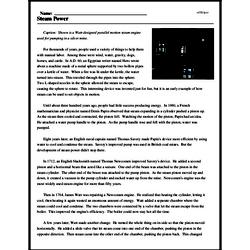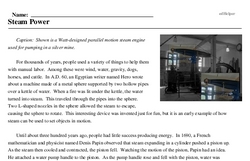Steam Power
Caption: Shown is a Watt-designed parallel motion steam engine used for pumping in a silver mine.
For thousands of years, people used a variety of things to help them with manual labor. Among these were wind, water, gravity, dogs, horses, and cattle. In A.D. 60, an Egyptian writer named Hero wrote about a machine made of a metal sphere supported by two hollow pipes over a kettle of water. When a fire was lit under the kettle, the water turned into steam. This traveled through the pipes into the sphere. Two L-shaped nozzles in the sphere allowed the steam to escape, causing the sphere to rotate. This interesting device was invented just for fun, but it is an early example of how steam can be used to set objects in motion.
Until about three hundred years ago, people had little success producing energy. In 1690, a French mathematician and physicist named Denis Papin observed that steam expanding in a cylinder pushed a piston up. As the steam then cooled and contracted, the piston fell. Watching the motion of the piston, Papin had an idea. He attached a water pump handle to the piston. As the pump handle rose and fell with the piston, water was pumped.




